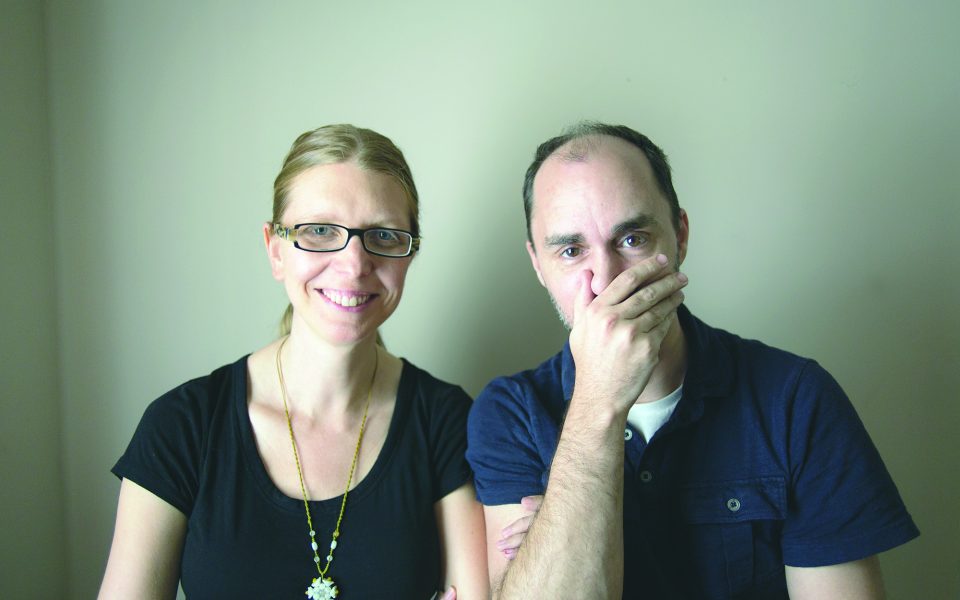by Daniel Wirtheim
Harvey Robinson and Carolyn de Berry share more than a 2-month old baby; they share a creative life. They’re partners in Monkeywhale Productions and a Greensboro couple since 2003.
Last week they were invited to discuss their process in a series, Conversations on Creativity, at the Weatherspoon Art Museum. The series was inspired by Tom Burckhardt’s installation Full Stop, a full-sized painting studio sculpted from cardboard and centered on a blank canvas set in the middle of the room. Jumpstarting the creative process was the theme of the evening.
As a child, Robinson was a professional actor in England and did some touring in France. It was his early passion for theater that paved the road for Robinson’s directing career.
“At some point, some friends of mine got together and we started this improv group; we did it for five years,” Robinson said. “I was always the funny sidekick or the priest.”
Robinson received a film degree from the UNC School of the Arts and started making films with his friends under the collective name of Monkeywhale Productions, inspired by their own invented creature.
Monkeywhale Productions makes documentaries, commercial films and music videos. Robinson works as director and director of cinematography.
Robinson chooses subjects that he has an emotional attachment to, subjects whose work has inspired him.
A drunken performance by the band Langhorne Slim inspired one documentary. Leonardo Drew, a prodigal sculpture and artist who Robinson met while working at the Weatherspoon inspired another. “Cry No More,” a somber music video completed over a three-day period with Rhiannon Giddens of Carolina Chocolate Drops, was a reaction to the Charleston Massacre.
De Berry’s still photography is used to document productions. She produces, shoots B-roll and helps on set. Besides being partnering in Monkeywhale Productions, de Berry contributes a piece of photojournalism to Triad City Beat’s Shot in the Triad section.
In her photographs, de Berry looks for narrative. She cites a class that she took from Sam Abell, a photographer who worked for National Geographic for many years, as helping her shape her artistic vision.
“One of the things that really resonated with me — and kept me going in a dark time creatively, later — was that he talked about his father, who was a serious hobbyist and was really a beautiful photographer,” de Berry said. “Sam would go out and shoot things from life with him and so Sam talks a lot about making a ‘photographic life,’ and it’s the act of looking. It’s the act of bringing your camera on your shoulder every day and exploring and being curious, and that’s what makes you a photographer, not how much money you make, who your clients are, where you’ve been published, if you’ve had a gallery show. That for me, was the piece of confidence that I needed to start new projects.”
De Berry has been documenting the demolition of buildings in Greensboro, buildings that she felt an emotional attachment to. As a self-proclaimed “newspaper dork,” de Berry felt the right kind of balance between social outreach and creative storytelling at an altweekly . The move was partly inspired by Silvia Plachy, who contributed a photo a week to the Village Voice, an altweekly in New York City.
Together, Robinson and de Berry have contributed to the 48 Hour Film Project — de Berry shooting B-roll and Robinson directing. But Robinson doesn’t watch his own work, he can’t stand to see his own mistakes. He leaves the critiquing to de Berry.
“I think we influence one another in the edit,” said Robinson. “When Carolyn is selecting photographs, I will say, ‘I don’t think this one works in context.’”
“Or we just do the really fast version,” said de Berry. “I’ll show you five photographs and you go, ‘No, no, no, yeah’ — that’s the fun part.”
Join the First Amendment Society, a membership that goes directly to funding TCB‘s newsroom.
We believe that reporting can save the world.
The TCB First Amendment Society recognizes the vital role of a free, unfettered press with a bundling of local experiences designed to build community, and unique engagements with our newsroom that will help you understand, and shape, local journalism’s critical role in uplifting the people in our cities.
All revenue goes directly into the newsroom as reporters’ salaries and freelance commissions.


Leave a Reply